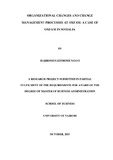| dc.description.abstract | The environment in which organizations operate in is ever changing and for survival hence organizations ought to develop and implement various strategies geared towards survival in a turbulent environment and to increase their competitiveness. Various models of change management have been developed by various scholars: they include Lewin’s (1947) three step model of change, Kotter’s (1996) eight-step model, Kanter et. al (1992) model of change management, Bullock & Battern (1985) four-phase model of planned change and Senge’s (1990) learning organizational model. The primary objective of the study was identify employees’ attitude and understanding of change and change management (processes and practices) within Oxfam with the general objective been to gauge the level of acceptance, resistance or complacency Oxfam employees were likely to express with regard to change, and to present the findings in a manner that would assist Oxfam employees to clearly comprehend the concept ‘change. The findings concluded that Oxfam needed to improve on communication and increase effort of continuously incorporating the views of the staff in the change process. The research was conducted through a case study where qualitative research for data collection was applied. Primary data was obtained through personal interviews using an interview guide which was administered to selected staff members in key strategic areas of Oxfam in Somalia. Use was also made of other available Secondary data that was obtained from various periodic journals, weekly Bulletins, monthly Executives Directors communications on the changes process from the Headquarters, Oxfam’s Country Strategic plans and various reports obtained from the intranet and the communication channels of the organization. The data collected was summarized according to the study theme being organizational changes and change management processes at oxfam, a case of oxfam in Somalia and analysed using content analysis. With regard to the findings from the formal interviews, the views echoed by employees provided a useful insight into what employees believed to be happening within the Oxfam with regard to change and change management. These views must be taken into consideration in order to create effective organizational change within the Oxfam. Overall, employees interviewed felt their needs were not being well met, with most employees feeling frustrated and de-motivated with the change process taking too long than anticipated with minimal communication. This study recommended empowerment of employees and the introduction of voicing activities to aid in strengthening the introduced change because it considers the voices of employees that may be discriminated against or are otherwise disadvantaged within the Oxfam. Empowerment and voicing activities would enable the latter to make their views known and change initiators can implement suitable strategies to mobilize and manage their support for the change agenda. | en_US |

